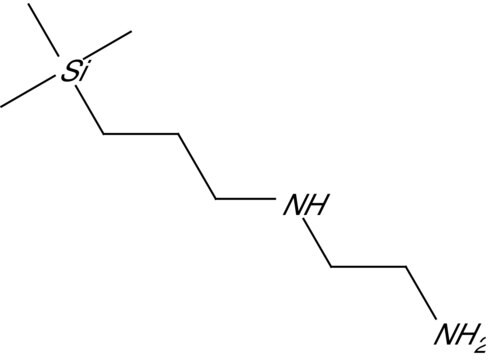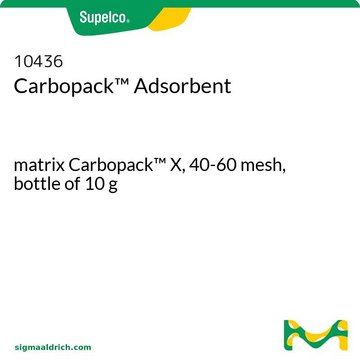추천 제품
제품 라인
Carbopack™
형태
granular
포장
bottle of 50 g
기술
LPLC: suitable
표면적
~24 m2/g
기질
Carbopack™ Y
기질 활성군
carbon
입자 크기
120-400 mesh
공극 크기
~0 cm3/g macroporosity
~0 cm3/g mesoporosity
~0 cm3/g microporosity
~0 Å pore diameter
density
~0.38 g/mL (free fall density)
분리 기술
reversed phase
유사한 제품을 찾으십니까? 방문 제품 비교 안내
일반 설명
Carbotrap®/Carbopack™ adsorbent can withstand high bake-out temperature without losing the mechanical and chemical integrity. It has a high affinity for isoprene and does not retain significant amounts of water. Furthermore it has a tendency to pulverize if it is packed too tightly. Carbotrap®/Carbopack™ adsorbent was used to quantitatively determine trace amounts of volatile organic compounds (VOCs) in air. It was also used for designing sampling protocols on the basis of its retention volume of the gaseous organic compounds of interest.
A graphitized carbon black (GCB) can be non-porous or porous. The graphitization process results in a highly pure surface with great adsorption and desorption (if required) properties. Surface interactions depend solely on dispersion (London) forces. These particles are:
Generally, GCB adsorbents offer weaker relative adsorptive strength compared to carbon molecular sieve (CMS) adsorbents, and similar relative adsorptive strength compared to spherical graphitized polymer carbon (SGPC) adsorbents. Our Carbopack products are a type of GCB adsorbent.
For more information about any of our specialty carbon adsorbents, please visit sigma-aldrich.com/carbon
- Granular
- Friable
- Used for molecules with an analyte size relative to C3-C20+ n-alkanes
- Hydrophobic (can be used in high humidity environments)
Generally, GCB adsorbents offer weaker relative adsorptive strength compared to carbon molecular sieve (CMS) adsorbents, and similar relative adsorptive strength compared to spherical graphitized polymer carbon (SGPC) adsorbents. Our Carbopack products are a type of GCB adsorbent.
- Particles are 40 mesh and smaller
- Use 40/60 mesh to prevent channeling (if observed with a 20/40 mesh Carbotrap® adsorbent)
- Use smaller mesh (60/80, 80/100, etc.) for all other applications
- Use the smallest particle size available as long as the application can handle the pressure drop
For more information about any of our specialty carbon adsorbents, please visit sigma-aldrich.com/carbon
애플리케이션
Carbopack™ Y was used for determination of contamination caused by pesticides like alachlor, atrazine, captan, formothion, lindane and phosalone in atmospheric samples. Carbopack™ Y was modified with mono-molecular layer of heptakis-(2,3,6-tri-O-methyl)-ß-cyclodextrin and was used in gas chromatography to study the effect of size and spatial structure of adsorbate molecules on adsorption of organic vapours.
법적 정보
Carbopack is a trademark of Merck KGaA, Darmstadt, Germany
Carbotrap is a registered trademark of Merck KGaA, Darmstadt, Germany
Storage Class Code
11 - Combustible Solids
WGK
nwg
Flash Point (°F)
Not applicable
Flash Point (°C)
Not applicable
가장 최신 버전 중 하나를 선택하세요:
이미 열람한 고객
Adsorption of organic vapors on the Carbopack Y carbon adsorbent modified with heptakis-(2, 3, 6-tri-O-methyl)-?-cyclodextrin.
Kudryashov SY, et al.
Russian Journal of Physical Chemistry A, 84 (3), 495-502 (2010)
Comparison of Tenax TA and Carbotrap for sampling and analysis of volatile organic compounds in air.
Rothweiler H, et al.
Atmospheric Environment, 25 (2), 231-235 (1991)
Gas phase retention volume behavior of organic compounds on Carbotrap graphitized carbon.
Pankow JF.
Journal of Chromatography A, 547, 488-493 (1991)
Plant Volatile Analysis.
Linskens HF and Jackson JF.
Modern Methods of Plant Analysis, 19, 54-56 (1997)
Li-Ming Yuan et al.
Analytical chemistry, 78(18), 6384-6390 (2006-09-15)
Single-walled carbon nanotubes (SWNTs) have high surface area, high adsorption ability, and nanoscale interactions. In this study, capillary columns including SWNTs, ionic liquid (IL), and IL + SWNTs for GC were prepared. The separation results showed that SWNTs possessed a
문서
Carbon Molecular sieves (CMS) are a versatile range of adsorbents that can be tailored for specific applications. Supelco® scientists have been synthesizing synthetic CMS carbons for several decades, starting from tailoring of the starting polymers/copolymers, to modifying the final properties of the subsequent CMS carbon.
자사의 과학자팀은 생명 과학, 재료 과학, 화학 합성, 크로마토그래피, 분석 및 기타 많은 영역을 포함한 모든 과학 분야에 경험이 있습니다..
고객지원팀으로 연락바랍니다.





